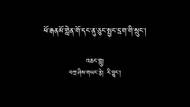Video Overview
Abstract:
Buddhist psychology has offered refined models of the mind-body system, such as in terms of the five aggregates and dependent co-arising. These models remarkably converge with contemporary developments in cognitive and affective psychology and neurosciences. In particular, current developments about emotion patterns, the self pattern and the interplay of brain networks, seem to resonate with Buddhist psychology models. Meditation states and traits can thus be understood as related to such converging models and findings. After considering such theoretical aspects, I will address our neuroimaging and neuroelectrical studies with the outstanding participation of Theravada Thai Forest Buddhist monks, with related findings about meditation states and traits. Taken together, our findings highlight an enhanced regulation of the mind-brain in the long-term meditators, which may resonate with other traditions, such as in Vajrayana practices.
Speaker Bio: Antonino Raffone
Antonino Raffone completed a Master in “Psychology” and a Doctorate in “Cognitive Psychology and Science” at Sapienza University of Rome. He is currently Associate Professor at the Department of Psychology of Sapienza University of Rome (Italy), and Visiting Professor and Advisory Faculty at Nalanda University (India). He is also Director of the Interuniversity Center ECONA at Sapienza University of Rome, President of “Consciousness, Mindfulness, Compassion – CMC – International Association”, and Chief Editor of the Specialty Section on “Consciousness Research” of “Frontiers in Psychology”. His internationally recognized research is interdisciplinary, with a particular focus on cognitive neuroscience of consciousness and meditation. Finally, he is a dedicated Soto Zen practitioner.
- Good morning or good afternoon or good evening, everyone, thanks for your interest in this presentation. And I do appreciate the opportunity to speak in these very interesting events organized by Dr. Maria Kozhevnikov and the University of Singapore. I think it’s very timely and very interesting to address the topic of this conference. So, what I will be saying is about meditation, Buddhist psychology, and the regulation of the mind brain.
- Okay, we really, I think, I have to acknowledge, still nowadays and ensure into next centuries, in future, the great insights about the mind of the Buddha and really with a very refined the Buddhist psychology, about consciousness about the mind states which impressively convergence with the current neurosciences of cognitive neurosciences, affective neurosciences and neurosciences of consciousness. My area of research is really to show this great convergences.
- So, I am also pleased to show you this slide about the unseen Nalanda University in northern India, that was really so in partly involved in the elaboration and transmission of, of core teachings about the mind and its liberation, but also very fine insights about the mind, the consciousness and I’m very pleased and honored to be involved as a visiting professor nowadays in the beautiful new developments in the current Nalanda University also with emphasis on ecology.
- Now, let me say a few words about the basic model of the mind in Buddhist psychology, you know about the five aggregates of the mind body system starting from rūpa, which can be related to the body including the sensory inputs from the different modalities, then there is feeling, which can be pleasant, unpleasant or neutral. Then there is perception or commission cognition like conceptualization and mental formations like emotions, motivations and consciousness. But the what is beautiful about this model of the mind, which is still very much resonating with contemporary developments is really the interaction between the mind and the body we will say in contemporary terms, Mind Brain Body interactions, and the highlights about the consciousness and the interactions, the interplay between consciousness and the other mental factors and the also the interactions between cognition and emotion.
- So it’s really about patterns, dynamic patterns, in the mind, brain body system, and contemporary views about emotions really emphasize this idea of patterns, like in this very interesting development by Izard and this also very interesting development about a pattern theory of self by Sean Gallagher, and let me mention that nowadays I’m really delighted to be involved with Sean Gallagher and other several researchers about neuroscience in education really, about understanding how the pattern theory of self can converge with Buddhist psychology insights and current developments in the neuroscience of meditation really with a broader picture about the idea that if you practice meditation, if you practice the related wisdom, dharma, transformation, you can deeply transform not only your attention your consciousness, but also the self in a more healthy, flexible, and wholesome way. And so I will say something in this talk about the our studies that we have been doing in our lab and content collaborating scientists about neuroscience, cognitive neuroscience studies with the outstanding participation of a Thai Forest Theravada Buddhist monks and nuns in Amravati Monastery in England and in Santa Clara monastery in Italy, let me say something about this tradition, which is really pretty now practice in the West, in this tradition really is highlights really fundamental aspects of the practice besides the Four Noble Truths, but also these cultivation of awareness.
- And interestingly, Achan Venerable Amaro currently abroad in Amaravati Monastery as written a beautiful book on small ball great mountain where really showed the convergences between the teaching called teachings about awareness in the Thai Forest the Theravada Buddhist tradition and its auction practices in which are so nicely related to the vaginal Yana tradition. So, the really, the idea is that when we practice goes deeply into realization of non duality, and the groundless ground of awareness, really is, you can see that the different traditions in Buddhism but possibly also across other contemplative wisdom, traditions really converge. And I will say something also about our neuro-scientific insights related to these practices.
- So, and also based on this status, we have also developed a brain theory of meditation, BTM ,with collaborators and this theory is really related to, for example, let me say something about the highlights of our findings. Of course, in science, neuroscience, in psychology, we often have to simplify practices, also meditation practices. For example, an influential distinction is about focused attention meditation, and open monitoring meditation. Keeping in mind that these are two sides of the same coin your practice in reality. So, when we have focused attention meditation, it relates to sametha or shamatha meditation which really has to do with working with the regulation of attention and developing these calm abiding of the mind. And basically, what we have done in this fMRI neuro-imaging, the functional resonance, functional magnetic resonance imaging experiment, to ask the the marks and the group of confirmed participants with a short term meditation experience to automate in focused attention meditation Samatha, an open monitoring meditation Vipassana, in also we take in green, you can see non meditative rest condition.
- So, what we have found is that in many areas of the brain, in frontal ,temporal parietal lobes, you get the get the deactivated, so reduce, you can see in view, many reductions of activations in these areas, which can be related to the idea that when the mind when there is development of this, calm abiding with Samatha or Shamatha meditation, many activations in the brain gets in some sense, become more silent, more deactivated. So the idea is that when our mind becomes more involved in this silence also the brain becomes more silent in some ways. And this is what also the what happens when we contrast open monitoring meditation with the rest, what we find is that here that we found the particular activations in some areas of the left hemisphere of the brain thus suggesting that when the the emphasis is really on these, just observe whatever arises in the field of experience in the present moment, there is this highlight in the left hemisphere, which is related also to the not so much to language in this case, but really, in this capacity of these witnessing observer function of the mind, brain, just witness with the opening, whatever arises without getting involved in these indices.
- And of course, when we your contrast, open monitoring meditation and focused attention meditation, we can see more activations with the open monitoring meditation is compared to the focus the attention meditation, in this highly trained group of monastics, which really gives us the idea that when you are involved in a deep training of the mind, and also possibly realizing non duality, and this really resting in the fuel field of this groundless ground of awareness, there is the possibility, we suggest to regulate in a fine manner, which areas and neurons of the brain lit up in a given moment. So it’s really what I like to say is that those speculatively of the stages that just as we become skilled in a movement with our right hand, when there is deeper mental training through meditation, the related factors in the Noble Eightfold Path, that really, there is possibility of these very fine regulation of what which areas of the brain gets involved with, in a given moment. So the idea is really to be sharper. We don’t need to activate so many neurons in the brain, but the right one, the skillful ones.
- And then, you know, this very influential review about the neuroscience of mindfulness meditation by Yuan Tang and collaborators in a prestigious journal showing that really, when meditators get engaged in practice, meditation practice, these practices can to structural and functional neuroplasticity involve many layers of the brain through the evolution of the brain going from the deeper levels of the amygdala and striatum to the really the most recent in the evolution, acquisition of brain areas the prefrontal cortex, like multiple prefrontal regions and I would like to highlight the three major central core brain networks, Default Mode Network, salience network, and central executive networks, among others, that really seems to be the central in orchestrating the regulation of cognition, attention, affect, and also in mind body interaction.
- So, my idea will be that theoretical our theoretical idea will be that when really contemplative or lay meditation practitioners go to a deep training of the of the mind, that transformational of the interaction between the five aggregates discovers that we have seen before and making the self also more flexible involves transformation of interactions of brain areas within these networks between these networks, and between these networks and the rest of the brain and the body, the body aggregate. And let me show you this interesting study by Christoff et al. showing what happens when there is mind wandering: the mind is just walking wandering without Mita awareness without mindfulness, this witnessing awareness that we have discussed before you ,see that many areas in default mode network and central executive network lit up. But then just when there is this meta-awareness of the mind wandering going on, look many neurons, many areas of the brain become more silent so this is the idea of this powerful cultivation of these witnessing awareness that we have discussed through the meditation possibly even more if we realize this field of awareness, beyond the duality of subject and objective, the study was performed with the non meditators, but we can get the understanding over what is the potential of just be cultivating this is meta awareness through deeper meditation and practice as a state and as a frame.
- Okay, and along these lines, in our study with the Thai Forest Theravada, Buddhist monastics, this is together with the fMRI study, we have also performed an EMG, electromyographic study with a much higher temporal resolution, we have also performed EEG study though the EMEG one as a higher temporal resolution.
- So, what we have done is really trying to investigate the interactions between areas within and between these core brain networks that I have shown you before and in different bands of the G going from this lowest one like the Delta bomb to the theta to the alpha band, the higher frequency bands, the even more higher frequency beta band and gamma band. So, this is basically what we have seen is the, how much there is this cabling is phase coupling, these we can say which relates also to the synchronization within and between these central brain networks across these frequency bands. So, you see here that going to the more red, yellow color, it means that there is a stronger coupling interactions within there between these networks, perhaps a bit less than the gamma bomb in rest in non medical team rest in the long term and those that I will just display now what will happen when the mind becomes very collected through the Samatha or Shamatha practice, blue, deep relaxation, if you like of these release of these stronger interactions between these rocks, in different bands, except for the half a band, which probably becomes the main carrier of signals in the brain, an interplay of signals in the brain in when they go into the focused attention meditation.
- And again, also with the open monitoring, personalized meditation, we see a kind of easy relaxation of these strong interactions between the core brain networks of the brain except for the Alpha band. So the idea is that when the monks go in this meditative state, based on their deep mental training, which also includes wisdom cultivation and ethics, cultivation, very important. Actually, the mind brain becomes more regulated, more orchestrated, and possibly through the emphasis of coherence in the half a band. And let me show you another what we believe is a kind of spectacular result in terms of neuroscience. Looking at the era we find here a picture of different brain rates in EEG, in this case, electroencephalography, many long term meditators, the monastics and the control group, just short term meditators. Look at the spectacular difference. Red are the long term meditators. Black the short term meditators. And this is the frequency, going from the lowest to highest frequencies.
- And look this huge difference in alpha band across the different forms of meditation, focused attention, meditation, open monitoring meditation, but we have also your metta loving kindness meditation, in the most anterior electrodes. frontal, even more than posterior electrodes and in the Alpha band. So, really, we have seen a prominence of an anterior Alpha treatment, as well as synchronization of coherence of the Alpha treatment in the brain of these long term virtuoso meditators, that seems to be a kind of grey, not so much modulating by the status, different state, whether it is normally the rest of the tension meditation, open monitoring meditation, or loving kindness meditation, though, that seems to be a more pronounced involvement in Samatha, Shamatha focused attention meditation.
- So, and then, we have also highlighted in our more theoretical work, this is with Professor Narayananan Srinivasan, and is in the past and it is at the University of Allahabad, and we have suggested that also based in our isolated flower, brain theory of meditation, that when there is practice of mindfulness meditation, there is involvement of the so called multiple demand system of the brain, which he was alighted by John Duncan, in 2010.
- And actually, the idea is that basically, when there is this involvement through these education, mindfulness meditation practices, there are effects on this multiple demand system of the brain, which is very involved in the regulation of different aspects of attention and cognition. And this one, by explaining why, through the meditation practice, in particular, the long term practice, there are effects on the different aspects of attention, metacognition, cognitive flexibility, executive functions, and so on. And not only as suggested by Yi-Yuan Tang and Michael Posner, meditation practices have effects on the timing of brain networks, but also on the training of brain states. And you can see that there are effects not only on the brain, but also on the aggregate of the body and through the mind brain body system, as we have seen through the sympathetic traditional and the parasympathetic division of the atom autonomous system that we can understand that this changes in the mind brain states and going through the thalamus, the Thalamus, excuse me, the Insula, which are deeper layers in the brain regulation, but also the frontal cortex, and then the top down regulation of states through the autonomous nervous system that goes, also affects, organs in the brain and also through the autonomic nervous system. And in some sites, making more flexible and LPD interaction interactions between mind the brain and body, the 500 gates, which we have started, acknowledged in Buddhist psychology.
- And then I think I finished this presentation and I would like to thank you very much for your attention and awareness together. And I very much look forward to the very interesting discussions, discussions, which are planned for this conference including your questions. Thank you very much.
 Loading ...
Loading ... 


































































































